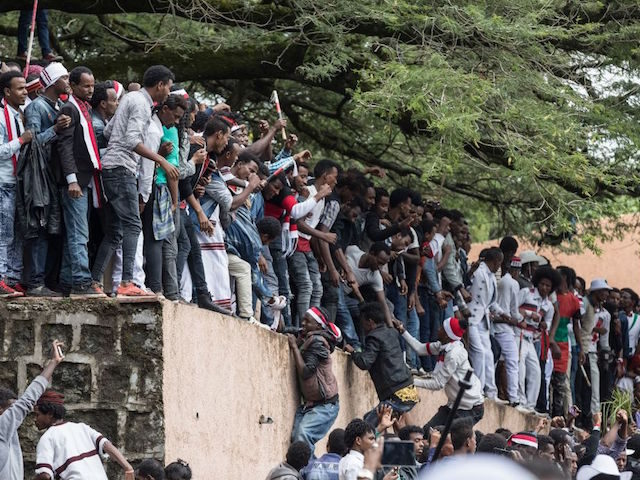This morning’s key headlines from GenerationalDynamics.com
- Thousands of Ethiopian Oromos flee into Kenya, threatening regional stability
- Fears grow that Ethiopia’s ethnic clashes will destabilize the region
Thousands of Ethiopian Oromos flee into Kenya, threatening regional stability

Deserted streets in Ethiopia’s capital city Addis Ababa, as businesses closed after strike called by Oromo activists (AFP)
Over 8,000 Ethiopians, mostly ethnic Oromos, have fled Ethiopia since Saturday and are pouring into an emergency refugee camp being set up in Kenya. The camp is in the town of Moyale, the capital of Marsabit County in Kenya, and is on a plot partially owned by the governor of Marsabit.
Moyale is a border town split into two parts, with one side in Ethiopia and one side in Kenya. The Oromos fled from Moyale in Ethiopia when Ethiopian soldiers on Saturday shot nine civilians. According to Ethiopian state media, the soldiers shot the civilians by mistake in a botched raid, after mistaking them for members of a banned activist group, the Oromo Liberation Front (OLF).
But several residents of Ethiopia’s Moyale said that it was not a mistake at all, but was intentional on the part of the soldiers, and specifically targeted at random at a crowd of residents:
It was then a military vehicle came along. The military jumped out of the car and started shooting aimlessly, killing indiscriminately. Some of them were killed in their homes. Some of them were killed while they were having their lunch. Some others were killed while they were selling in their shops.
Massive anti-government protests began in Ethiopia’s Oromia region late in 2015 and spread to the neighboring Amhara region, leaving hundreds dead and resulting in tens of thousands of arrests. A state of emergency was imposed in October 2016, allowing mass detentions, and imposing numerous restrictions on people’s movement and communication.
The first state of emergency ended only a few months ago, in August 2017. Anti-government protests began again, and by February there were millions of protesters. This led to the shock resignation of the prime minister Hailemariam Desalegn on February 15. In his letter of resignation, he wrote, “I see my resignation as vital in the bid to carry out reforms that would lead to sustainable peace and democracy.”
Not surprisingly, Hailemariam’s resignation did not end the protests but instead led to more activism. The result was that the government’s Council of Ministers declared a new state of emergency that “would be instrumental in thwarting ethnic-based conflicts in the country and safeguarding the constitutional order.” The Nation (Kenya) and AFP (14-Mar) and Reuters and AFP
Fears grow that Ethiopia’s ethnic clashes will destabilize the region
As I have previously described in a detailed generational analysis of Ethiopia’s protests, Ethiopia’s last generational crisis war occurred in 1991, when the Marxist Derg dictatorship was overthrown. Since 1991, the government has been largely controlled by the ethnic Tigrayans, who are a market and government dominant minority, comprising only 6 percent of the population. Although the Tigrayans comprise only a tiny fraction of the population, the Tigrayan governing coalition has been able to increasingly marginalized the two largest ethnic groups, the Oromo ethnic group (34 percent of Ethiopia’s population), and among the Amhara ethnic group (27 percent).
The kind of violence that occurred last weekend is typical of what happens in the generational Awakening era following a generational crisis war that is also a tribal or ethnic war. In these cases, when the war ends, the two warring groups reside in the same country, and sometimes even in the same villages and towns. As a result, memories of the massacres, rapes, mutilations, and torture that occurred during the war are constantly refreshed by seeing members of the other tribe on the streets and in the shops.
That certainly seems to be exactly what is happening here. The government is supposedly investigating what happened on Saturday and has promised that the guilty parties will be punished, but the most likely explanation is that the soldiers were ethnic Tigrayans who retain bitter memories of how the Oromos killed their wives or sons, and are getting revenge. No investigation will prevent that from happening again.
The anti-government protests are far from over, and they pose the largest challenge to Ethiopia’s ruling coalition since it took power in 1991.
In the last two years, more than 900,000 people have been forced from their homes. The Oromo Liberation Front is an activist youth movement of a kind that is typical in generational Awakening eras (such as America in the 1960s). Widespread protest strikes have closed down shops and businesses.
On Monday, a week-long “fuel blockade” protest action began, blocking roads and preventing fuel tankers from leaving the capital city Addis Ababa and supplying fuel to other towns.
The government is already without a prime minister, since the resignation of Hailemariam Desalegn on February 15. The massive protests and protest actions are threatening the government, and the brutal state of emergency is apparently having no effect in bringing the protests under control. With thousands of Ethiopians crossing the border into Kenya, a country with its own governmental crisis and ethnic problems, it’s feared that the unrest in Ethiopia could spread to other countries in the Horn of Africa. Guardian (London) and France 24 and Africa News and Bloomberg (6-Mar) and Africa News (28-Feb)
Related Articles
- Ethiopia declares state of emergency after shock resignation of prime minister (17-Feb-2018)
- General warns of US security danger if China acquires Djibouti seaport (11-Mar-2018)
- Ethiopia declares extraordinary six-month state of emergency (10-Oct-2016)
- Generational history of Ethiopia and Eritrea (14-Jun-2016)
- Tensions rise between Egypt and Ethiopia over Nile River dam (25-Jan-2018)
- Ethiopians crush Islamists in Somalia, forcing retreat to Kenya (02-Jan-2007)
KEYS: Generational Dynamics, Ethiopia, Hailemariam Desalegn, Tigrayans, Oromos, Amharas, Kenya, Moyale, Marsabit County, Oromo Liberation Front, OLF
Permanent web link to this article
Receive daily World View columns by e-mail

COMMENTS
Please let us know if you're having issues with commenting.